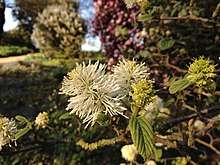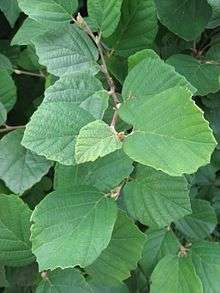Fothergilla gardenii
Fothergilla gardenii, also known by the common names witch alder,[1] dwarf fothergilla,[2] American wych hazel,[3] and dwarf witchalder is a deciduous shrub in the Hamamelidaceae family. It is one of two species in the genus Fothergilla.[1][2]
| Fothergilla gardenii | |
|---|---|
 | |
| Scientific classification | |
| Kingdom: | Plantae |
| Clade: | Tracheophytes |
| Clade: | Angiosperms |
| Clade: | Eudicots |
| Order: | Saxifragales |
| Family: | Hamamelidaceae |
| Genus: | Fothergilla |
| Species: | F. gardenii |
| Binomial name | |
| Fothergilla gardenii | |

Fothergilla gardenii foliage
Description
- Type: Slow-growing[2] deciduous shrub.[1][2]
- Height/spread: Max height and spread is 0.9 m (3 ft)[2] to 1 m (3 ft).[1]
- Leaves: Dark green, alternate leaves emerge in spring[1] and range in shape from oval[1][2] to obovate.[1] Sizes up to 6 cm (2.5 in) in length,[1] with irregularly[2] toothed margins.[1][2] Striking autumn colors, including bright red,[1] crimson,[2] orange, and yellow.[1][2]
- Inflorescences: Terminal cylindrical[1] spikes[1][2] to 4 cm (1.5 in) are borne in spring,[1] before the leaves emerge.[1][2]
Cultivation
- Hardiness: Fully hardy,[1] to -29 °C (-20 °F).[2] USDA zones 5-9.[2]
- Cultivation: Prefers full sun[1][2] or partial shade[1] and humus-rich, well-drained soil which is kept moist.[1][2] Full sun gives the best autumn color.[2] Does well in woodland gardens or shrub borders.[1]
- Propagation:
- Pests and Diseases: Trouble free.[1]
Etymology
Fothergilla is named for Dr. John Fothergill (1712-1780) of Stratford, Essex, a physician and introducer of American plants.[3]
Gardenii is named for Dr. Alexander Garden (1730-1791), an Anglo-American botanist and correspondent with Carl Linnaeus.[3]
gollark: The main attack on this is that you can, sometimes even using dedicated ASICs/FPGAs, run hashes *very fast* on a lot of possibilities and figure out what the original password was.
gollark: Yep!
gollark: The point is that for one hashed input you always have the same output, so you can compare values without storing what they originally were.
gollark: Encryption means you can encrypt something with a key then decrypt it with that key (symmetric encryption, anyway), hashing means that you irreversibly convert it to a different value.
gollark: It's not encrypted, it's hashed.
References
- Brickell, Christopher "The Royal Horticultural Society A-Z of Garden Plants (Volume 1: A-J)", 3rd ed. Copyright 1996, 2003, 2008 Dorling Kindersley Ltd., London. ISBN 9781405332965 pp. 452-453
- Hogan, Sean, chief consultant. 2003, 2004. "Flora A Gardener's Encyclopedia", Global Nook Publishing Pty Ltd, Timber Press. ISBN 0881925381. pp. 608
- Gledhill, David (2008). "The Names of Plants". Cambridge University Press. ISBN 9780521866453 (hardback), ISBN 9780521685535 (paperback). pp 169, 175
- Thomas G. Ranney and Nathan P. Lynch, Clarifying Taxonomy and Nomenclature of Fothergilla (Hamamelidaceae) Cultivars and Hybrids, HORTSCIENCE 42(3):470–473. 2007.
This article is issued from Wikipedia. The text is licensed under Creative Commons - Attribution - Sharealike. Additional terms may apply for the media files.